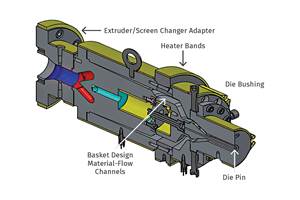Integrated Process Cooling Boosts Output, Cuts Costs
Closed-loop system helps an extrusion processor maintain quality of reusable straws and other products.
If you ask an extrusion processor to identify the most critical factor in the process, many will answer, cooling. SELA Inc., York, S.C. would be one of those.
was founded in 1983 to produce liquid-sampling devices. These are clear, rigid PP pipes used for taking samples in fuel-storage tanks, waste-treatment plants, water-treatment facilities, etc. While SELA still makes this product, its main ´óĎó´«Ă˝ today is reusable PP and PE drinking straws, which it produces in wall thicknesses of 0.20-0.25 in. (roughly twice the thickness of disposable straws) for hospitals, cruise ships, amusement parks, tumbler manufacturers, etc. The company operates three extrusion lines at its 16,000 ft² plant, where plans are on the horizon to add another 6000-7000 ft². It also runs one injection molding machine to produce straw tips.
Consistent process temperatures for its three extrusion lines are important to SELA because they help ensure the highest possible clarity, especially when using a high-cost clarified resin or colorant. With cooling being a limiting factor in extrusion, having a topnotch process-cooling system also allows SELA to increase its throughput while controlling water temperatures.
SELA traditionally had used air-cooled chilling systems, recalls Ronnie Roberts, president and owner. But when adding the third extrusion line in 2007, the firm was open to other alternatives. SELA was looking for a system that would help maintain a stable heat profile and deliver proper cooling capacity from start to finish. It wanted to steer clear of air-cooled chilling systems because of already high ambient temperatures in the plant.
SELA ultimately decided to install a closed-loop system from (U.S. headquarters in East Dundee, Ill.). The integrated system, which replaced two 5-ton air-cooled chillers plus a smaller unit, included a 32-ton Ecodry central cooler, which cools each of the three extruders and the injection press. The Ecodry unit supplies cooling water to single-zone Microgel chiller/TCU units located at each downstream cooling tank and to a dual-zone Microgel chiller/TCU unit dedicated to the injection machine.
All units provide SELA with the ability to use “free cooling” when ambient temperatures permit. With so-called free cooling, the central cooler and the Microgels provide water at the proper temperature to processing equipment without needing compressors to generate chilled water. The Microgel units automatically cycle off their compressors to satisfy the cooling load at the exact temperature requirement. This process allows SELA to lower energy consumption and cut costs. SELA also chose the Microgel dual-zone chiller/TCU based on its ability to satisfy both chilled and, if needed, warm water for specific applications.
The Ecodry and machine-side chiller/TCUs provide SELA with more consistent temperature control while also eliminating water waste, says Roberts. He says the move to the new chilling system resulted in:
• Energy and water savings of approximately $10,000/yr compared with the alternative setup originally considered. In all, water use declined from approximately 25,000 gal/month to 4000 gal/month, none of which is used for process cooling.
• Increased throughput on the extrusion lines by as much as 15%.
• Continued consistency in quality.
• Maximum uptime due to decreased maintenance and system redundancy.
SELA has more recently installed a second 32-ton Ecodry unit, giving the plant 64 tons of capacity for more efficiencies and anticipated cost savings, while also providing increased redundancy.
Roberts notes, “Frigel’s closed-loop system allows us to maintain a stable heat profile, which permits us to increase our throughput and maintain the quality that we are known for in our product lines.”
Related Content
Tight-Tolerance Molder Dips Toe in Extrusion Waters
Midwest Precision Molding brings extrusion capacity in-house to assist a customer that was having a sourcing issue with its existing overseas suppliers.
Read MoreMedical Tubing: Use Simulation to Troubleshoot, Optimize Processing & Dies
Extrusion simulations can be useful in anticipating issues and running “what-if” scenarios to size extruders and design dies for extrusion projects. It should be used at early stages of any project to avoid trial and error and remaking tooling.
Read MoreHow to Select the Right Tooling for Pipe Extrusion
In pipe extrusion, selecting or building a complementary set of tooling often poses challenges due to a range of qualitative factors. Here’s some guidance to help you out.
Read MoreHigh-Output Extruder Series Now Comes in Smaller Size
Series offers higher output, lower melt temperatures and energy savings.
Read MoreRead Next
Making the Circular Economy a Reality
Driven by brand owner demands and new worldwide legislation, the entire supply chain is working toward the shift to circularity, with some evidence the circular economy has already begun.
Read MoreBeyond Prototypes: 8 Ways the Plastics Industry Is Using 3D Printing
Plastics processors are finding applications for 3D printing around the plant and across the supply chain. Here are 8 examples to look for at NPE2024.
Read MorePeople 4.0 – How to Get Buy-In from Your Staff for Industry 4.0 Systems
Implementing a production monitoring system as the foundation of a ‘smart factory’ is about integrating people with new technology as much as it is about integrating machines and computers. Here are tips from a company that has gone through the process.
Read More













